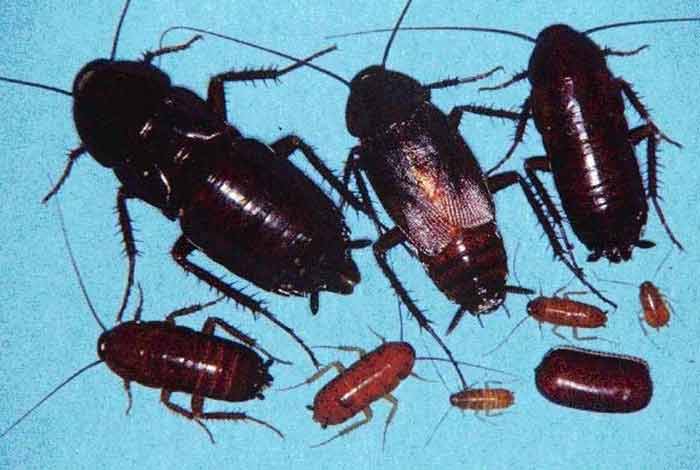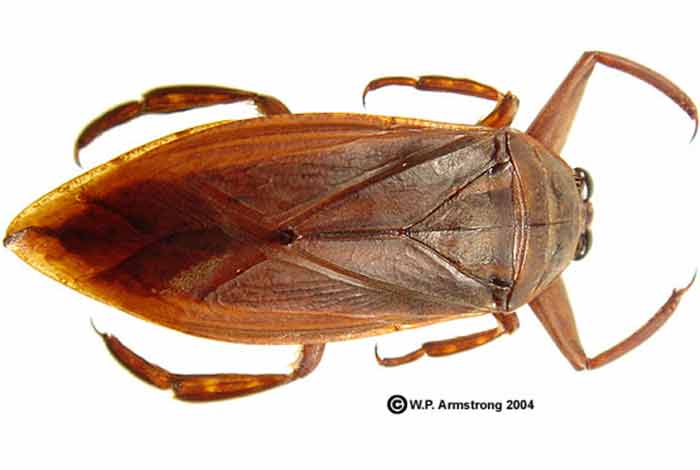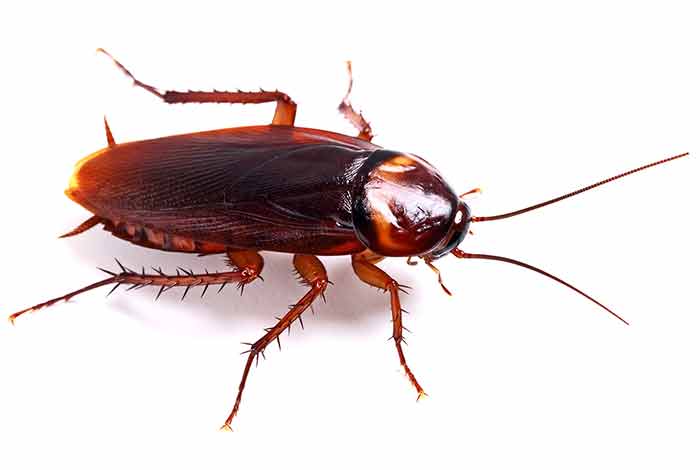When placed together, most people can effortlessly conclude that a water bug and a cockroach are the same but slightly different insects. Truth is, these are two very distinct animals found in different biological categories. Their behaviors, habitats among other features allows one to adequately differentiate between the two. Following are the differences and similarities with pictures.
Table of Contents
Are Water Bugs Roaches?
After taking a deep dive into various authentic resources it’s clear that in fact, water bugs are not roaches. Which also implies that roaches are not water bugs.
However, there is a type of roach, the oriental cockroach (Blatta orientalis), native to Africa, that is actually called a water bug. This roach, sometimes referred to as black beetle, prefers damp areas and in terms of appearance it is shiny and black or dark brown in color. It is just a roach called a water bug…but it really isn’t a water bug.

Water bugs are a specially defined type of insect species that mostly live in humid and water-filled areas, hence the name. The true bugs found in the order Hemiptera are very distinct from touches in terms of appearance, behaviors, diet, and habitats. These bugs are further defined into four distinct types which are discussed in another text.

Cockroaches, on the other hand, are not too biters. Parasitic in nature and tends to live on the low side of life minding their own business. The most prevalent type of roaches that come closest to water bugs is the oriental cockroaches. An American type that tends to dwell in damp areas.

Differences
So you’ve read about the definition, let’s have a deeper look into the differences between these two types of insects.
For this phase of differences, we will use the giant water bugs, the most common type of true bugs.
Water Bugs
- Aquatic- as the name suggests, water bugs mostly habitat in water, dampen areas and placed with a high percentage of humidity. Their bodies especially the swimmers are designed in such a way that they can swim faster than even fish.
- Predators – they actually hunt and feed on other tiny insects. Especially if you have a pool, water bugs will tend to hand out around that area as there are plenty of tiny insects there.
- Toe biters – they have very painful bites, similar to wasps, except in this case they can only reach the toes.
- They fly – especially during the mating season, they move from one water body to the next.
- Attracted to light – whether you have pool lights or ones at the porch, these tiny critters are somewhere there hiding.
- Large in size – especially for the giant water bugs, they are over two inches long and one inch wide. That’s a lathe size for an insect, seeing that some even measure 12 mm. Furthermore, some may even grow to over four inches long.
- Body appearance- they are tan-brown in color and have a flattened body. The only time they have an extended body is when they’re about to fly. Plus, their antennas are found under their heads, above their eyes.
- Survival tactics – water bugs have clawed front feet to allow then to capture their prey. They also have a short, piercing mouthpart under their heads for the same purpose.
- Water bug babies don’t have wings hence can’t fly.
Cockroaches
- They live in wood – for example, the cardboard boxes, wooden cabinets, spaces and creeks on doors and other wooden surfaces.
- They are scavengers – preying on leftovers and cramps of food left anywhere, especially eating areas like the kitchen or dining areas
- They don’t bite unless under extreme duress.
- They have wings but also rarely fly. They’re more of crawlers than fliers. Besides, the wings on either type of cockroaches are either small or non-existent.
- They prefer dark and hidden areas hence very unlikely to be found where the light shines.
- Medium in size – they would never get to the same size as the water bugs. Probably closer to an inch.
- Appearance – they’re body shape is oval with body parts asymmetrical to each other. They have very long antennas similar to the length of their bodies, and a hairy appearance thanks to its six legs covering the spine.
- They have a downward-facing head which you can hardly see unless you go looking.
Well, there you have it, water bugs and cockroaches are actually very dissimilar to each other. From their appearance, how long they grow, where the head is located, the size of the antennas, these two critters have different looks.
Their habitat too, what belongs to the water, stays in the water and the cockroaches stay on land specifically where there is a woody smell or wood shavings. Although the water bugs can live on land and the roaches can survive in water, that’s not their original home.
They have different diets. The cockroaches are not selective in nature, they feed on what they find from cramps, leftovers, and garbage. Water bugs, however, go hunting for their insect of choice. Their bodies are mechanized in a way that they can easily target prey and attack. Their hind feet tend to paralyze their prey using a liquefied enzyme found on their proboscis.
Behaviors are also very different in that the water bugs love to be seen. Whenever there’s the light they will walk across the light and just stuck around.
The cockroach, however, loves dark and hidden areas like the wooden cabinets, the attic where people rarely visit. This also leads to the water bugs having to defend itself constantly hence the tendency to bite which is unlike the cockroaches.
Lifespan with and without food
A roach can live for a whole week without taking water. It can also live for a month without food. Different types of roaches vary in their life span living up to an average of 12 months. American roaches live for about one year while German roaches live for about 100 days. Roaches feeds on anything hence starving them to die may not be a better way of eradicating them.
Water bugs live anywhere for a period of 1 to 4 years. They can live for 2 weeks without water and 4 weeks without food. Its life span is shortened by breeding. An increase in reproductive effort results to less energy to maintain body tissues resulting to a shorter life span. According to Gilg Mathew, an American Midland Naturalist, male and female water bugs that are virgins live longer than those that breed as elaborated by.
Finally, cockroaches are a true definition of pests, they have parasitic features that highly depend on humans, water bugs however simply hunt for themselves and can survive without humans.
Similarities
There are similarities between these two insects. In terms of appearance, they somewhat look the same. The brown tan color or reddish-brown hue they have in their bodies makes them seem similar – especially when you find one lurking on the inside of the house.
Both of them have parental care, water bugs come together in time of breeding while roaches also prefer being surrounded by other roaches.
They have similar habits of entering the home through cracks, holes or pipes that lead to the house and exit through drains. They both react and fear human beings by biting them or hiding away from them.
They’re also full-bodied. The water bug may be long but in terms of height, they’re very close to the ground, similar to the cockroaches. Their flying mechanism is somewhat limited to specific species of cockroaches. You already know that adult water bugs fly, but very few cockroaches fly or use their wings at all.
When you see water bugs and roaches, you would gladly classify one with the other, but when you look at them intently, you will notice that they are actually very different creatures. They behave differently, they’re adapted differently and have very different characteristics.
Further Reading
- How to get rid of Bed Bugs on Clothes-Can they Live, Bite through or Travel on Laundry
- Fumigation for Bed Bugs-Cost & Preparation
- How to get Bed Bugs out of Carpet with Cleaner & Powder
- How Long do Bed Bugs Live Without Food, Host, Air, in Cold & After Spraying
- Bed Bug Rash on Skin, Pictures, Treatment, Allergy & Symptoms
- Where do Bed Bugs Hide and how to Find them
- Mosquito Bites vs Bed Bug Bites-What’ are the differences
- Identifying Bed Bug Eggs- How they look like, Images & destruction
- How do you know if you have Bed Bugs-Symptoms & Signs
- Bed Bug vs Spider Bites- Differences with Pictures
- Bed Bug Sniffing Dogs-How they smell, Sense, Roscoe, Breeds & Cost
- What are Bed Bugs? Names in other Languages
- Where do Bed Bugs come from? Causes, how you get them & Start
- How to Kill/Get Rid of Bed Bugs Fast Yourself Naturally for Good
- Bed Bugs in Hair Symptoms, Pictures & Get rid
- Types of Bed Bugs
- Bed Bug Poop/Droppings-How it looks like, Pictures +Identification
- Bed Bug Shells, Cast Skin & Exoskeleton
- Can you See Bed Bugs with the Naked eye? Pictures, Size, Color & Anatomy
- Dust Mite vs Bed Bug Bites
- Bed Bug life cycle-Eggs, Baby(Nymph) to Adult Stages & Pictures
- How to Detect Bed Bugs-Detectors, Light & Verifi Reviews
- How to know if Bed Bugs are gone after Treatment & what to do
- Will Bleach Kill Bed Bugs-How does it work?
- Best Bed Bugs Traps- DIY Homemade, Co2, Yeast + Reviews
- How to Deal with Bed Bugs in your Car
- Bed Bugs in Couch-Covers, Signs & How to Get rid
- How to Kill Bed Bugs with Steam: Best Steamers & Guide + Tips
- Does Alcohol Kill Bed Bugs? Rubbing, Isopropyl & Percentage
- How Long do Bed Bug Bites Last, Take to Appear, Go Away & Heal
- Natural Predator of Bed Bugs-What Insects/Bugs eat Bed Bugs?
- Can Bed Bugs Live in TVs & Other Electronics? How to get them out
- Do Bed Bug Bites Itch or Hurt?
- Bed Bug Interceptor-How it works, DIY & Reviews
- What do Bed Bug Bites look like? Pictures & Identification Steps
- What Attracts Bed Bugs & things they Hate /Dislike Most
- Can Bed Bugs make you Sick? How are they Dangerous?
- Can Bed Bugs Fly-Do they have Wings-How Far can they Travel
- Diatomaceous Earth for Bed Bugs-How to Use & Best Reviews
- DIY Bed Bug Heat Treatment: Success Rate,Temperature Chart, Preparation & Reviews
- Does Vinegar Kill Bed Bugs? Can it be Used for Bites?
- How to Get Rid of Bed Bugs on Mattress- Best Covers, Protectors & Encasement Reviews
- Can Bed Bugs live on or Bite Dogs & Cats (Pets)?
- Bugs that look like Bed Bugs-Beetles & Others that Resemble or Mistaken
- Bed Bug Bombs-Do Foggers work? Effectiveness & Reviews
- Bed Bug Repellents -Natural Homemade, Creams, Electronic & Reviews
- How do Bed Bugs Spread? Are they Contagious? How Fast/Easily from Person, Room or House?
- Best Bed Bug Sprays-DIY Homemade, Natural, Brand Reviews
- Flea Bites vs Bed Bug Bites + Differences & Pictures
- How to Prevent Bed Bugs-Bites while Sleeping at Home, School, Hotel & Travelling